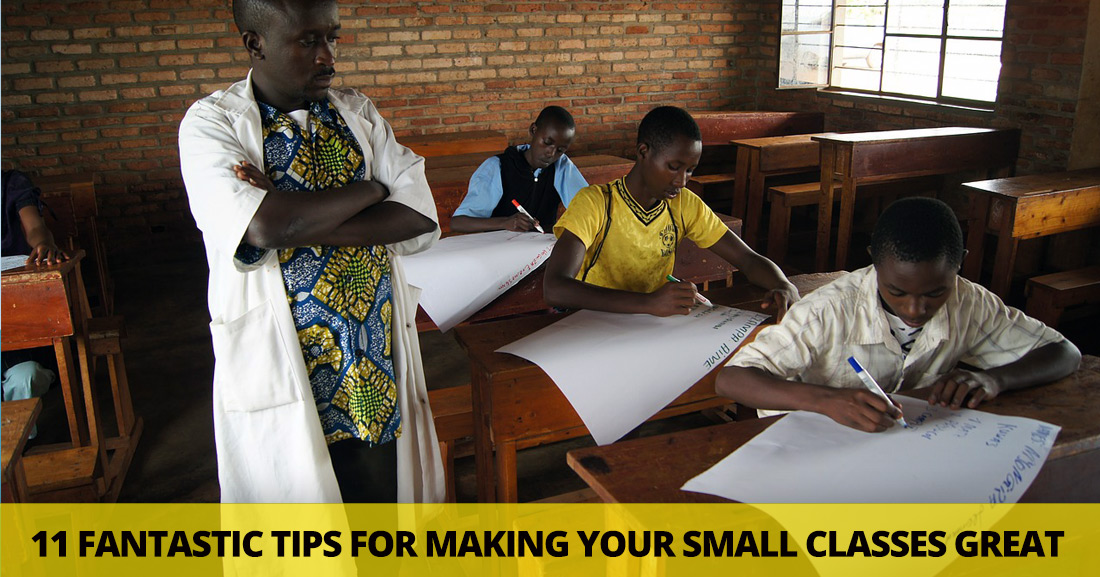The Best Things Come in Small Packages: 9 Best Reasons to Teach a Small Class


It was challenging for many reasons, not the least of which was simply the number of students in class. And while experience may be the best teacher in situations such as this, whether they are two students or ten, there are some tips to keep in mind for making the most of those intimidate settings. Here are some things for you to keep in mind if you teach a small class.
It can be easy to simply go into autopilot when you are in front of a class, but you’ll have to be more observant than that if you are in front of a small class. Always be on the lookout for individual needs and areas of struggle. One advantage to having a small class is being able to tailor your instruction to the individual needs of your students. To do this, you’ll have to be aware of what those needs are. So make sure you are always in observation mode and not just in teaching mode to make sure your students get what they need from you.
If you have a very small class but an average sized classroom, it might feel almost cavernous even with the whole class in attendance, stressing your low numbers. To eliminate this discomfort, divide your classroom into different areas or sections to serve different functions. Have a reading area, a place near the board where you can teach from up front, a conversation area set with comfy chairs, or whatever functions you want from your classroom. If you divide things up a bit and move students around through the class, that empty feeling won’t permeate everything you do and your big classroom will feel just right.
One very important thing to keep in mind with a small class is that many activities will take less time than they do with a larger class. This is true even when students are working independently. So it’s key that you over prepare for class. Always have multiple activities ready to fill the time if you need it. My personal rule is to have twice as many activities planned as I would for a more typical class. Some zero in on what I am teaching that day, and others are just general language activities that I can use anytime I need them (and I can carryover from one day to the next when I don’t use them). Also, don’t be afraid to do the same activities more than once over the span of a few days. Your students will still benefit from the practice and will get a confidence boost from the success they are sure to have.
I’m not talking about couches and floor pillows here though that might work in your class. When you teach a small class, it’s important to make your classroom as welcoming and supportive as possible. If you have shy students in your small class, it can be very uncomfortable for them, making them feel like they are always in the spotlight. They will stand out just by the fact of being there. If you can make your classroom more supportive and welcoming for them, more comfortable, it will help them feel more at ease even if they are often in the spotlight.
Interpersonal conflicts will be a bigger deal when you have fewer students in class. Keep things happy in your classroom by helping your students work out difficulties and keep communication open. If you have a couple of students who just don’t get along, you’ll have to work extra hard to keep a pleasant atmosphere since you won’t just be able to sit them at different ends of the class.
You can’t make all of the people happy all of the time, but with a small class you just might be able to keep your students happier than they might be in a large class. When your student numbers are lower, you have the freedom to give your class members more input in what you do in class. Do they like games? Play more of them. Do they prefer technology? Set up your own multimedia lab. Are they struggling with too much homework? Or can they take on more? Do they want to learn about sports instead of food? Workplace vocabulary rather than academic vocabulary? Whatever it is your students like, are interested in, or suggest about class, with small numbers you have the freedom to adjust to their suggestions. That doesn’t mean you disregard what you planed on teaching. It just means spending more of your time and energy on one area rather than another. Ask your students for feedback and adjust things accordingly.
Being able to work one on one regularly is one of the greatest advantages of smaller classes. You have the time to talk to each student and offer guidance or advice on their English studies. With a bigger class, many students get lost in the mix. Don’t let that happen with your small class. Use the numbers to your advantage and your students’ by giving your students some direct, individualized attention.
You may find with your small class that there is a lower level of energy in the room. To counteract that, make sure you get your students moving every day. Do some Total Physical Response exercises. Stress kinesthetic activities. Go outside. Keep your students moving to keep their energy level up and keep them from slipping into lethargy.
Just because you have a small class doesn’t mean you can’t have other people come through your door. Whenever you can, invite other students or classes to join you. Your students will benefit from the change of company and conversation partners and from mixing up the normal pairings for in class activities. And you just might be able to share teaching responsibilities for a day or two with another teacher at your school.
Fewer students means fewer logistics to navigate when planning and executing field trips, so take advantage of it and get out of the classroom. Anywhere your students can use English in a natural setting, including your local coffee shop, is good experience for them. So when you can, get out of the classroom and into the world, which is the best classroom of all.
Just because you are the teacher doesn’t mean you shouldn’t participate in classroom activities. Pair up with your students and give them some individualized time with a native speaker. Join in group discussions and offer your opinions. Your students will enjoy getting to know you better, and you will help them by giving them an up close experience talking with a native speaker.